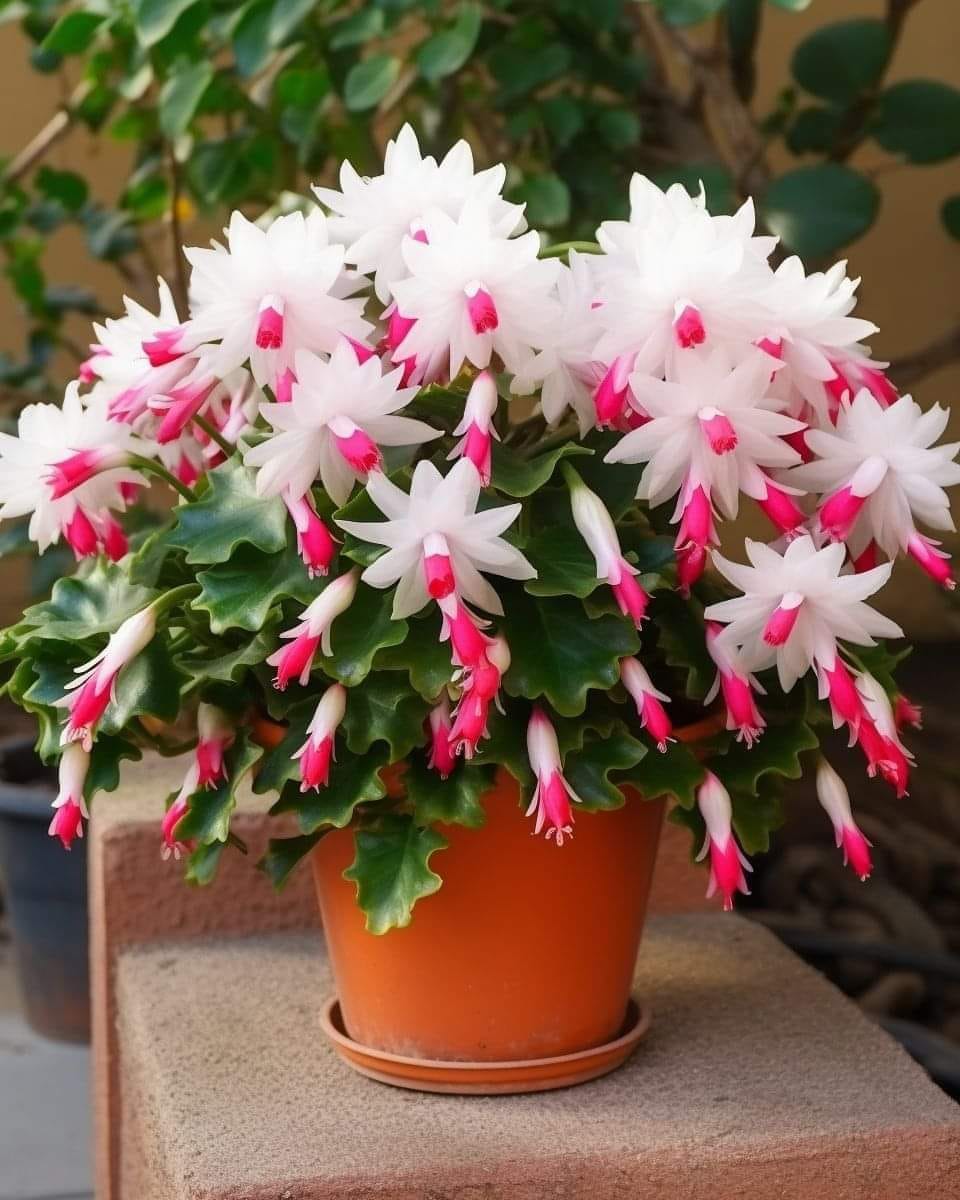If you’re lucky enough to have a Christmas cactus (Schlumbergera) in your collection, you probably know how stunning their bright, colorful blooms are during the holiday season. But did you know that with the right care, you can encourage your Christmas cactus to bloom more than once a year? With a bit of attention to light, watering, temperature, and some clever tricks, you can keep your Christmas cactus in bloom throughout the year. Here’s how:
1. Identifying Varieties: Understanding Your Holiday Cactus
Before diving into the care specifics, it’s important to identify which type of holiday cactus you own. The most common types are:
Christmas Cactus (Schlumbergera bridgessii): Known for its red, pink, or white blooms, this variety typically blooms around late December.
Thanksgiving Cactus (Schlumbergera truncata): This variety usually blooms earlier, around late November or early December. Its segments have more pointed tips compared to the Christmas cactus.
Easter Cactus (Schlumbergera gaertneri): A rarer type that blooms around Easter, with more slender and longer segments.
Understanding the variety you have will help you anticipate its blooming cycle and provide the best care to encourage blooms at the right times.
2. Creating the Optimal Environment for Blooms
The environment you provide your Christmas cactus plays a major role in how well it blooms. Here’s how to ensure it’s in the perfect spot:
Light: Place your cactus in bright, indirect sunlight. Direct sunlight can scorch the leaves and reduce the quality of blooms. A windowsill with filtered light works well, but make sure it’s not in the path of intense afternoon sun.
Temperature: Christmas cacti thrive in temperatures between 60°F to 75°F (15°C to 24°C). If the temperature drops below 50°F (10°C), bring the plant indoors. A stable temperature range helps your cactus remain healthy and sets the stage for blooming.
Bonus Tip: Avoid placing your cactus near heating or cooling vents, as fluctuations in temperature can cause stress and disrupt blooming.
3. Watering and Humidity: Keep It Just Right
One of the most important factors for promoting blooms is watering. Overwatering or underwatering can lead to poor growth and fewer flowers.
Watering: Water your Christmas cactus thoroughly, but let the soil dry out slightly between waterings. Overwatering can lead to root rot, while underwatering can cause dehydration. Ensure that your pot has good drainage to prevent water from sitting in the bottom.
Humidity: Christmas cacti love humidity, especially during the winter when indoor air tends to be dry. Place a shallow tray filled with water and pebbles underneath the plant to increase humidity. Alternatively, you can mist the leaves occasionally, but avoid spraying directly on the flowers to prevent them from getting damaged.
Bonus Tip: If you live in a dry climate or during winter, consider using a humidifier in the room to keep humidity levels up, promoting better blooming.
4. Nutrition and Repotting: Feed and Refresh the Soil
Christmas cacti are relatively low-maintenance when it comes to feeding, but providing the right nutrients at the right time can help maximize blooming potential.
Fertilization: During the blooming season (fall and winter), feed your Christmas cactus with a balanced, water-soluble fertilizer once a month. After blooming, switch to a bi-weekly feeding schedule to promote healthy growth and prepare the plant for the next cycle of blooms.
Repotting: Christmas cacti prefer to be slightly root-bound, so you don’t need to repot them every year. Repot only when the roots outgrow the pot, and when you do, choose a pot that’s only slightly larger than the current one. Overpotting can stress the plant and prevent blooming. Fresh potting mix is essential for healthy root growth.
Bonus Tip: When repotting, gently remove the plant from its pot, shake off old soil, and trim away any dead or rotting roots before replanting.
5. Inducing Blooms: The Light and Temperature Trick
If you’re looking to get your Christmas cactus to bloom more than once a year, you’ll need to trigger its natural blooming process. Christmas cacti require a period of darkness and cooler temperatures to stimulate the buds to form.
Light Control: In late summer or early fall, start by placing your cactus in a dark room for 12-14 hours each day. You can cover it with a box or place it in a closet to ensure it gets enough darkness. During the day, return the plant to a bright, indirect light source. This “long night” period helps signal the cactus that it’s time to bloom.
Temperature: Along with darkness, cooler temperatures between 50°F to 55°F (10°C to 13°C) are ideal for triggering buds. A cool room or basement that stays within this range will work well for the four weeks required to initiate blooming.
Bonus Tip: Keep the cactus in this dark, cool environment for about 4 weeks. Once buds start to form, move it back to its regular spot with more light and warmth to promote blooming.
6. Propagation: Grow New Plants After Blooming
After your Christmas cactus finishes blooming, you can propagate it to create new plants. This is a great way to expand your collection and even share your plant with friends or family.
Cuttings: Take cuttings from the plant after the bloom cycle has finished, using a sharp knife or scissors. Choose healthy leaf segments (two to three segments long), and allow the cut ends to callous for 1-2 days to prevent rot.
Rooting: Place the cuttings in a small pot filled with well-draining soil. Keep the soil lightly moist and place the cutting in a warm, bright location with indirect sunlight. The cutting should root in a few weeks and can eventually be repotted into a larger container.
Bonus Tip: To encourage faster rooting, you can dip the cut ends of the segments in rooting hormone before planting.
Conclusion: Keep the Blooms Coming
With the right care and attention, your Christmas cactus can bloom more than just once a year. By providing it with optimal lighting, temperature, humidity, and nutrition, along with inducing dormancy to trigger blooming, you’ll enjoy its stunning flowers multiple times throughout the year. Remember to keep the plant healthy by avoiding overwatering, fertilizing on time, and propagating to expand your collection. Whether it’s the holiday season or any other time of the year, your Christmas cactus will continue to bring joy and beauty to your home.
More Articles you Might Like
-
Texas Toast Sloppy Joes: The Crunchy, Cheesy Upgrade You Didn’t Know You Needed
There’s something timeless about sloppy joes. For generations, this saucy, savory, and slightly sweet ground beef sandwich has been a go-to comfort food in American kitchens. It’s quick, filling, and family-friendly—perfect for busy weeknights. But what if we told you there’s a way to take this classic dish up a notch? Enter the Texas Toast…
-
Classic Pig Pickin’ Cake
When it comes to Southern desserts, few sweets shine as brightly as the Classic Pig Pickin’ Cake. This nostalgic cake, sometimes called a “Mandarin Orange Cake,” has roots deep in Southern tradition. It gets its playful name from its frequent appearance at pig pickin’s—Southern-style barbecue gatherings where communities come together to enjoy slow-cooked pork, sides,…
-
Lemon Garlic Butter Chicken with Creamy Parmesan Pasta
There’s something irresistible about the combination of tender, golden-browned chicken paired with a creamy pasta coated in Parmesan cheese. Add the brightness of lemon, the depth of garlic, and the richness of butter, and you have a recipe that feels indulgent yet approachable enough for a weeknight dinner. Lemon Garlic Butter Chicken with Creamy Parmesan…



